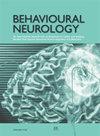血小板P2Y12抑制剂治疗和预防偏头痛的系统评价和荟萃分析
IF 2.7
4区 医学
Q2 CLINICAL NEUROLOGY
引用次数: 5
摘要
有人猜测和研究将偏头痛与血小板聚集和活化异常联系起来。P2Y12血小板抑制剂在偏头痛治疗中的作用尚未确定。我们的目的是评估血小板P2Y12抑制剂在经导管房间隔缺损封堵术(ASDC)后治疗偏头痛和预防新发偏头痛(MHA)的疗效。我们在PubMed、Web of Science和Cochrane图书馆的数据库中搜索了相关研究。主要结果是ASDC后头痛反应率和新发偏头痛发作率。包括对262名患有或不患有卵圆孔未闭(PFO)的偏头痛患者的四项研究,以及对539名接受抗血小板治疗的患者进行的三项研究,以预防ASDC后新发偏头痛。P2Y12抑制剂对偏头痛的总有效率为0.64(95%CI:0.43至0.81)。对于接受ASDC的患者,与不包括P2Y12抑制物的方案相比,使用包括P2Y1 2抑制物在内的抗血小板方案,导致新发偏头痛发生率降低(OR:0.41,95%CI:0.22-0.77,P=0.005)。我们得出结论,P2Y12血小板抑制剂可能对有或没有PFO的偏头痛患者具有主要预防作用,并预防ASDC后新发MHA。P2Y12抑制剂的反应性可以帮助选择从PFO封闭中受益的候选者。值得进一步进行大规模研究,以探索P2Y12抑制剂的作用,特别是在一定比例的偏头痛患者中。本文章由计算机程序翻译,如有差异,请以英文原文为准。
Platelet P2Y12 Inhibitor in the Treatment and Prevention of Migraine: A Systematic Review and Meta-Analysis
There have been speculation and research linking migraine with abnormalities of platelet aggregation and activation. The role of the P2Y12 platelet inhibitor in the treatment of migraine has not been established. We aim to evaluate the efficacy of the platelet P2Y12 inhibitor in the treatment of migraine and prevention of new-onset migraine headache (MHA) following transcatheter atrial septal defect closure (ASDC). We searched the PubMed, Web of Science, and Cochrane Library databases for relevant studies. The primary outcomes were the headache responder rate and the rate of new-onset migraine attacks following ASDC. Four studies for a total of 262 migraine patients with or without patent foramen ovale (PFO) and three studies involving 539 patients with antiplatelet treatment in the prevention of new-onset migraine following ASDC were included. The pooled responder rate of the P2Y12 inhibitor for migraine was 0.64 (95% CI: 0.43 to 0.81). For patients who underwent ASDC, the use of antiplatelet regimens including the P2Y12 inhibitor, compared with regimens excluding P2Y12 inhibitor, resulted in a lower rate of new-onset migraine (OR: 0.41, 95% CI: 0.22 to 0.77, P = 0.005). We concluded that the P2Y12 platelet inhibitor may have a primary prophylactic role in migraine patients with or without PFO and prevent new-onset MHA after ASDC. The responsiveness of the P2Y12 inhibitor could help select candidates who would benefit from PFO closure. It warrants further large-scale research to explore the role of the P2Y12 inhibitor, particularly in a proportion of migraine patients.
求助全文
通过发布文献求助,成功后即可免费获取论文全文。
去求助
来源期刊

Behavioural Neurology
医学-临床神经学
CiteScore
5.40
自引率
3.60%
发文量
52
审稿时长
>12 weeks
期刊介绍:
Behavioural Neurology is a peer-reviewed, Open Access journal which publishes original research articles, review articles and clinical studies based on various diseases and syndromes in behavioural neurology. The aim of the journal is to provide a platform for researchers and clinicians working in various fields of neurology including cognitive neuroscience, neuropsychology and neuropsychiatry.
Topics of interest include:
ADHD
Aphasia
Autism
Alzheimer’s Disease
Behavioural Disorders
Dementia
Epilepsy
Multiple Sclerosis
Parkinson’s Disease
Psychosis
Stroke
Traumatic brain injury.
 求助内容:
求助内容: 应助结果提醒方式:
应助结果提醒方式:


